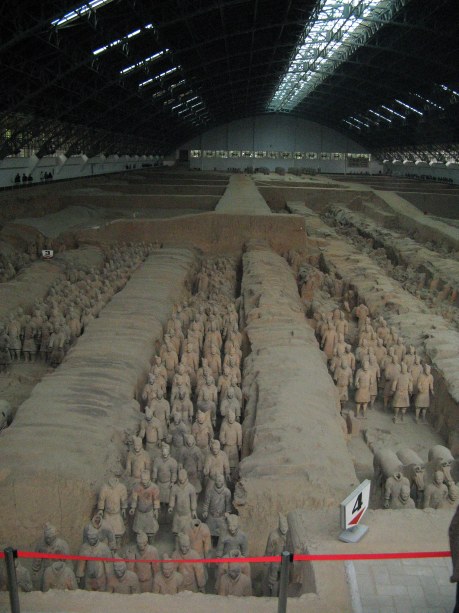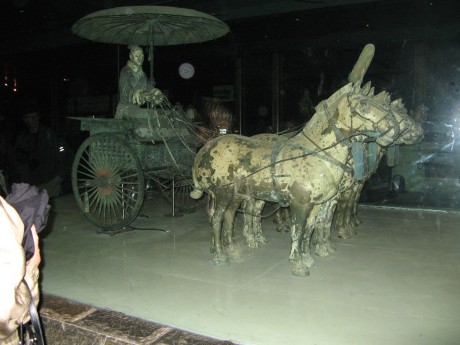China’s Terra Cotta Army is considered the eighth wonder of the world. And, rightly so. Isn’t this an amazing culture?

The Terra Cotta Soldiers face east and remain in the pit from which they came, standing at attention row by row. The building covering the pit is leaking slightly and is inadequate for preserving the soldiers, a problem the Chinese government has recognized and is addressing.

Point and shoot cameras cannot reach the fine details from such an immense area. Light is dim and only natural light is allowed into the building. When found, the soldiers were painted to look like they were alive. The atmosphere has destroyed the color leaving them a dull reddish color. Even so, we will have a good look at the soldiers. But first a bit of history.

This picture of a picture shows what they looked like before they were fully removed from the ground. The armor looks like bronze or leather, but it is jade. Pit #1 is the largest with 6000 figures of infantry, the first discovery in 1974. Pit #2 holds 2000 Calvary and archers and horses. Each soldier’s face and body are an exact replica of a real human. No two are the same. Pit # 3 was a command center full of dignitaries or politicians. Pit #4 holds the middle army, bronze chariots ½ size, and horse-drawn equipment wagons.

In the museum, this chariot is completely enclosed in a temperature controlled glass case.

This equipment wagon and its work horses is on display in the museum as well.
I was surprised to learn that in 1991 they discovered two nearby tomb mounds, the graves of a Ching Dynasty emperor and empress buried in separate tombs. They now know there are 73 of these tomb mounds in the area of the soldiers. A few of them have been opened, examined and buried back again. The rest will not be opened until they have the proper technology to care for these treasures. The technology to protect them still does not exist. The financial costs are enormous but there is wisdom in waiting.
During the intervening years, much has been learned about the Xian area (pronounced shy-ann), the soldiers, and the history of the Ching (also spelled Quing) Dynasty. Xian is in Shanxi Province which is considered the Cradle of Chinese Civilization.
Xian was the first capitol of China during the Ching Dynasty, the first of the thirteen dynasties. The first emperor, Ching Shu Wandi ruled in year 221 before Christ. He unified China. His dynasty only lasted until 206 B.C. He was a tyrant. He burned 250 Confucius Scholars alive. There is a mausoleum to honor them.
The second was the Hun Dynasty.
It was a slave society, a feudal society. When the Hun Emperor was 13 years old, he started to build his tomb. It took 37 years. It was the largest tomb in the world. He died at age 50 in 210 B.C. The Emperors threw their concubines into the tombs and buried them alive so they could not reveal the site of their burial.
The visit to Xian was as gratifying as the Great Wall. The public views four pits, but the Imax movie explaining it all, and the well done museum make this an unforgettable visit. And now a funny story.

In the gift shop, we actually got up close to soldier replicas. In the gift shop, we met the farmer who discovered the first pit on his land. He signs books for tourists who buy them, his official job since he can’t farm his land. He can no longer be photographed because the millions of flashes from cameras have damaged his eyes.
When it was known that President Clinton would visit Xian, the farmer was taught a bit of English to greet them. He learned enough English to say, “How are you?” He was coached that the Clintons will likely say, fine, thank you, and he should answer, I’m fine too. But, Clinton said, “Hello!” And the farmer said ‘Who are you instead of How are you? Clinton answered “I’m Hillary Clinton’s husband.” And the farmer said, “Me too.”
The Chinese feel warmly about the Clintons because they visited Xian first instead of Beijing or Shanghai.

These replicas can be purchased and shipped home. These soldiers also come with a replica of the weapons they held in their hands if you want to buy them.

The Terra Cotta Soldiers face east and remain in the pit from which they came, standing at attention row by row. The building covering the pit is leaking slightly and is inadequate for preserving the soldiers, a problem the Chinese government has recognized and is addressing.

Point and shoot cameras cannot reach the fine details from such an immense area. Light is dim and only natural light is allowed into the building. When found, the soldiers were painted to look like they were alive. The atmosphere has destroyed the color leaving them a dull reddish color. Even so, we will have a good look at the soldiers. But first a bit of history.

This picture of a picture shows what they looked like before they were fully removed from the ground. The armor looks like bronze or leather, but it is jade. Pit #1 is the largest with 6000 figures of infantry, the first discovery in 1974. Pit #2 holds 2000 Calvary and archers and horses. Each soldier’s face and body are an exact replica of a real human. No two are the same. Pit # 3 was a command center full of dignitaries or politicians. Pit #4 holds the middle army, bronze chariots ½ size, and horse-drawn equipment wagons.

In the museum, this chariot is completely enclosed in a temperature controlled glass case.

This equipment wagon and its work horses is on display in the museum as well.
I was surprised to learn that in 1991 they discovered two nearby tomb mounds, the graves of a Ching Dynasty emperor and empress buried in separate tombs. They now know there are 73 of these tomb mounds in the area of the soldiers. A few of them have been opened, examined and buried back again. The rest will not be opened until they have the proper technology to care for these treasures. The technology to protect them still does not exist. The financial costs are enormous but there is wisdom in waiting.
During the intervening years, much has been learned about the Xian area (pronounced shy-ann), the soldiers, and the history of the Ching (also spelled Quing) Dynasty. Xian is in Shanxi Province which is considered the Cradle of Chinese Civilization.
Xian was the first capitol of China during the Ching Dynasty, the first of the thirteen dynasties. The first emperor, Ching Shu Wandi ruled in year 221 before Christ. He unified China. His dynasty only lasted until 206 B.C. He was a tyrant. He burned 250 Confucius Scholars alive. There is a mausoleum to honor them.
The second was the Hun Dynasty.
It was a slave society, a feudal society. When the Hun Emperor was 13 years old, he started to build his tomb. It took 37 years. It was the largest tomb in the world. He died at age 50 in 210 B.C. The Emperors threw their concubines into the tombs and buried them alive so they could not reveal the site of their burial.
The visit to Xian was as gratifying as the Great Wall. The public views four pits, but the Imax movie explaining it all, and the well done museum make this an unforgettable visit. And now a funny story.

In the gift shop, we actually got up close to soldier replicas. In the gift shop, we met the farmer who discovered the first pit on his land. He signs books for tourists who buy them, his official job since he can’t farm his land. He can no longer be photographed because the millions of flashes from cameras have damaged his eyes.
When it was known that President Clinton would visit Xian, the farmer was taught a bit of English to greet them. He learned enough English to say, “How are you?” He was coached that the Clintons will likely say, fine, thank you, and he should answer, I’m fine too. But, Clinton said, “Hello!” And the farmer said ‘Who are you instead of How are you? Clinton answered “I’m Hillary Clinton’s husband.” And the farmer said, “Me too.”
The Chinese feel warmly about the Clintons because they visited Xian first instead of Beijing or Shanghai.

These replicas can be purchased and shipped home. These soldiers also come with a replica of the weapons they held in their hands if you want to buy them.
No comments:
Post a Comment